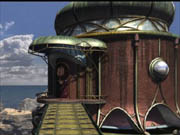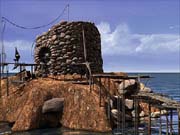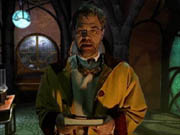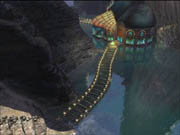Myst III: Exile Preview
Read on to see what you can expect from the Miller brothers' third Myst game.
Has there even been a game that generated as much division among PC game fans as Myst? On the one hand, there are millions of adventurers who consider it the closest thing to the perfect PC game ever created, a groundbreaking game that ushered in a new era of graphical excellence and that immediately captured the imagination of gamers across the globe. On the other, are the strident critics who dismiss it as "twiddleware" and who simply can't understand how someone can become so immersed in a gameworld that they consider lifeless and empty.

Regardless of which camp you belong to, though, there's no denying that Myst changed the face of PC gaming forever. The numbers alone speak for themselves: More than 10 million copies of Myst and its sequel, Riven, have been sold over the past seven and a half years, thanks in no small part to the fact that women--generally considered an inconsequential segment of the target audience of PC games--comprised nearly half of those who played the game. Hungry for all things Myst, fans devoured three Myst novels penned by Rand Miller, co-designer of Myst along with brother Robyn Miller. And literally dozens of Myst and Riven Web sites sprang up, all dedicated to feeding fans' interest in the music, language, and mysteries of the D'ni, the civilization around which both games revolve.
With that type of popularity, it wouldn't have been surprising to see four or five sequels to Myst hit shelves since that game's release in 1993. Instead, fans had to wait four years for Riven and another four for Myst III: Exile, which is slated for release this May. The reason for the long gaps between Myst games was partly financial: Myst stayed at the top of sales charts for years, and it would have made little sense to release a sequel when sales of the original game were so incredibly robust. The other reason was artistic: Cyan and the Millers wanted Riven not only to feature the same compelling gameplay of the original but also to incorporate the very latest advances in graphics technology.

When it comes to Myst III: Exile, however, the single biggest reason for the long hiatus between it and Riven is that the franchise has gone through some turbulent changes. Three different companies--Mattel, The Learning Company, and Ubi Soft--have held the rights to the Myst and Riven product line over the last several years. That state of flux brought unique stumbling blocks to the development of Exile, says Dan Irish, Ubi Soft's producer for the game. He also oversaw the development of Myst Masterpiece, realMyst, and Myst IV (yes, it's already in the works). "With every change came a new set of challenges and standards that needed to be met, in addition to my own," notes Irish. "Educating the top executives from each of the various companies became a regular event during the development of Myst III: Exile." And like the Millers--who longtime fans might be disappointed to learn had virtually no involvement in the game's development--Irish was dedicated to making Exile a top-quality product. Take the game's lush, fully orchestrated soundtrack: "No one argued with me on that issue, since it was a direct reflection of our commitment to developing a quality product."
New Faces, New Worlds

Though Rand and Robyn Miller weren't involved in the development of Exile, Rand Miller and Richard Watson of Cyan worked with Ubi Soft and award-winning development house Presto Studios--whose Journeyman Project games are often favorably compared to Myst--from the very beginning of the project, outlining the direction the story would follow. "Once they had a clear idea of the direction that we were going, they turned us loose," Irish says. "They gave us the canvas on which we could paint, we chose the colors, type of paint, and vision of the painting."
And just what direction does Exile take? Though set after the events in Riven, Exile doesn't pick up precisely where that game ended. Atrus, his wife, Catherine (whom players helped rescue in Riven), and their daughter are living on Tomahna, a flowering oasis that borders a rolling desert landscape. It's here that Atrus has been struggling to decide whether he should help the D'ni rebuild their shattered civilization or write a new age in which they can start afresh. Eventually--with the guidance of Catherine and the remembrance of his grandmother's advice--he chooses the latter course and writes a new age called Releeshahn.
As the game opens, Atrus is about to journey with his family to Releeshahn to see how the D'ni are faring on their new world, and he lets you stay in Tomahna as a sort of caretaker while he's away. Suddenly a wild-eyed figure materializes, sets Atrus' study ablaze, and snatches the Releeshahn book before you or Atrus can make a move to stop him. As he disappears, he drops the book of the age to which he's fled: Called J'Nanin, it consists of an elliptical island that Atrus wrote of many years earlier as a place where Sirrus and Achenar (Atrus' sons who wreaked havoc in Myst) could master the art of writing an age.

Following the thief to J'Nanin, you soon discover his name is Saavedro, and after reading his journal you learn that he originally hails from an age called Narayan--an age that according to Saavedro spiraled into cataclysmic destruction thanks to Sirrus and Achenar. Exiled on J'Nanin, Saavedro thinks only of finding the two rogues and punishing them for their crimes. But when he eventually realizes they're either dead or in a place where he will not be able to reach them, he sets his sights instead on exacting revenge on Atrus and his family.
While Saavedro bears some resemblance to the villains you tracked down in Myst and Riven, Irish points out that you will soon begin to understand what drives him to do the things he does--and as that happens you'll be drawn even further into the game. "Our goal was to provide a story with tremendous depth and [to] let players uncover the story at their own pace," says Irish. "And being exiled is something that everyone can relate to--imagine how you'd feel if you were trapped on a beautiful island, but your only real desire was to go home. Once you start understanding and empathizing with the villain, you'll be swept into the story."
Bringing Saavedro to life is Brad Dourif, who snatched the "King of the Psychos" crown from Bruce Dern with his roles in movies like The Exorcist III, the Child's Play series (as the voice of Chucky), and Blue Velvet. Dourif appeared for only a few minutes in the demo we played here at GameSpot, but if these small tidbits are any indication, it's clear that he'll be a formidable adversary.
If It Ain't Broke...

The age of J'Nanin serves as a "hub" in Myst III: Exile. From there you must find books that take you to three other ages. Voltaic is a dusty world of sand and sky, water and wind--a place where strange, obviously man-made constructions poke out of an otherwise dry and desolate landscape. Amateria is a sweeping mechanical wonderland in the middle of an endless black sea, with terrain consisting of basalt columns and geyser-formed mud pots, and it has some of Atrus' most sophisticated inventions dotting the landscape. As the name implies, Edanna is Atrus' vision of a paradise lost, an inward-growing tree whose massive, hollow trunk creates the perfect growing environment for a variety of exotic plant and animal ecosystems.
The Myst series has always featured state-of-the art graphics, and this third installment is no exception. Sporting 32-bit graphics running at resolutions of up to 1600x1200, the superb lighting effects and stunning level of detail--along with the compelling story, of course--should make it easy for adventurers to lose themselves in these strange, new worlds. And longtime fans will be pleased to know that the slideshow presentation of Myst and Riven, which didn't let you scan each "node" that you stopped at during your point-and-click exploration, has been replaced with a new engine that gives you the ability to explore every location more thoroughly than ever before. "The biggest changes that adventurers will find in this new chapter of the Myst saga is the ability to look around in 360 degrees of freedom, all while exploring a beautifully crafted world filled with exquisite detail," Irish says. "We've endeavored to create a world that suspends the player's disbelief more than previous products did, and I think that the attention to detail will surprise most players, even if they've played Myst or Riven before."

One complaint that even fans of the Myst series have is that all too often you find yourself stuck because you simply have no idea where to go or what to do next, a problem exacerbated in Riven because successfully completing a puzzle might yield an effect in a distant location. In Exile, however, the puzzles have been more thoroughly integrated into gameplay, and the story makes it clear what needs to be done. After chasing Saavedro to an observatory and finding the entrance locked, for instance, it's quite plain you must find another way into the building. Do that, and you'll come across an elevator that takes you to the level where he's fled--but because the gears have been tinkered with, the elevator doors are facing the wrong way for you to exit once you get there. Solve that problem, and you're rewarded with a holographic image of Atrus explaining that there are three books hidden on J'Nanin that you can use to link to the other ages--which in turn sets you off on a search to discover their locations and get past the obstacles that keep you from laying your hands on them. This doesn't mean the game will be easier than its predecessors--you'll still have to scour every scene for clues and objects you can manipulate--but it does mean the chance of frustration setting in is much less likely than before.
Despite these changes, it's unlikely that Myst III: Exile will change the minds of players who've taken great joy in lambasting the series over the years. Given the number of Myst fans who've thirsted for more of the game universe they've come to know and love, though, it's a safe bet that Ubi Soft and Presto Studios will be able to live with it.
Got a news tip or want to contact us directly? Email news@gamespot.com
Join the conversation